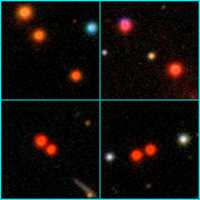Stars
VIDA researchers in the Stassun group are studying the physical processes that govern the birth and evolution of stars like the Sun. We are currently applying the tools and techniques of astro-informatics to this problem in two related thrusts:
Magnificent Failures: Discovery of a rare brown-dwarf eclipsing binary Brown dwarfs are often called “failed stars” because their low masses are intermediate to those of planets and stars. Until recently, the fundamental physical properties of brown dwarfs were largely unkown. The discovery of a pair of brown dwarfs in an eclipsing binary system provides the first direct measurements of the masses, diameters, temperatures, and luminosities of these failed stars. See the Vanderbilt Explorations website for a multimedia feature about this research, published in the journal Nature. Also check out NPR's Earth & Sky interview and radio story. |
- Using Vanderbilt's access to the SMARTS telescopes in Chile, we are monitoring with rapid cadence the brightness variations of millions of young stars over several years to find eclipsing binary stars. These serve as rare Rosetta Stones for determining the fundamental physical properties of stars and for testing the theoretical predictions of stellar evolution models. Highlights of this work include discovery of the first known pair of brown dwarfs (so-called 'failed stars') in an eclipsing binary system, and the first determination of birth order in a pair of 'identical twin' stars.
- Using the Sloan Digital Sky Survey, we are amassing the largest catalog to date of very wide, very low-mass binary star systems. The Sloan LOw-mass Wide Pairs of Kinematically Equivalent Stars (SLoWPoKES) project, led by Vanderbilt graduate student Saurav Dhital, will study the nature of the Milky Way galaxy's structure by establishing the survivability of nature's most fragile binary star systems.

A collage of four example wide binary systems discovered by the SLoWPoKES project. The upper two examples are in fact likely to be hierarchical triple systems, with the system at upper right likely containing a white dwarf member.
